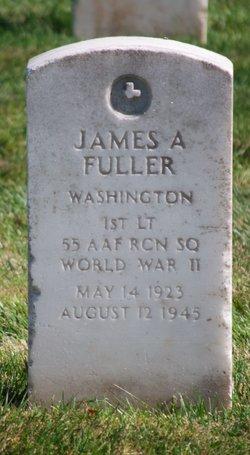James Albert Fuller
Pre-WSC Background
James Albert Fuller was born on May 14, 1923, to Albert (A.C.) and Stella Linde Fuller in Seattle, Washington. Fuller was his parent's only child, and he grew up in Bremerton, Washington where his father worked as a machinist at the Puget Sound Naval Shipyard and his mother worked as a salesperson at a dry goods store. A.C. Fuller was also a veteran of the First World War, serving from November 1917 through June 23, 1919. By 1940, Stella Fuller no longer worked and the household had three lodgers living with them, likely as a means to make extra money. The Puget Sound Naval Shipyard was established adjacent to the city of Bremerton on Sinclair Inlet in 1891, and it was the first dry-dock and repair facility in the Northwest capable of handling the largest ships. When settlers in Point Turner on Sinclair Inlet became aware of the Navy’s interest in purchasing their property, they asked $200 per acre though the Navy representative, Lt. Wyckoff, was only authorized to offer $50. Business leaders William Bremer and Henry Paul Hensel decided to create a new town in order to become wealthy by assisting Lt. Wyckoff in his quest; they purchases the property at the inflated price, then sold some of it to the Navy at their authorized price and convinced two other property owners to do so, as well. This began the town of Bremerton.
During World War I the shipyard expanded to include shipbuilding and continued to do so during the 1930s as the United States built up its fleet with the increased likelihood of war looming. Several Federal agencies directed money toward the Navy installation, and between 1933 and 1935 the Navy built a $1.5 million machine shop, described as the “finest machine shop in the nation and the largest west of the Mississippi River.” By 1939, the shipyard employed more than 6,000 employees, included A.C. Fuller. In 1940, Navy Yard Puget Sound was the primary naval shipyard on the West Coast and the only one with the capability of handling aircraft carriers and battleships.
Bremerton High School was originally founded in the 1920s, with the school moving to its West Bremerton location in the 1940s. Fuller graduated from Bremerton High School in 1941.
WSC Experience
Fuller began his post-secondary education at Washington State College in the fall of 1941 as a Mining major. He joined the Associated Muckers Club, an organization for those majoring in mining. For the two years, he was at WSC, Fuller distinguished himself academically. He was on the all college high scholarship roll, and in March of 1943, he was honored by Phi Kappa Phi, a national scholastic honorary fraternity, in recognition of his outstanding scholastic record during his freshman and sophomore years.
Registering for the draft on June 30, 1942, Fuller listed his summer place of employment as Sullivan Mining Company in Burke, Idaho. The discovery of silver in 1884 led to the establishment of Burke in Shoshone County, along with a railroad built by the Northern Pacific. Hundreds of miners lived there “in a canyon so narrow they scarcely had room for streets,” resulting in the building of a hotel over Canyon Creek rather than beside it. The town ended up being home to several well-known mines in the Coeur d’Alene Mining District, and through the years was the scene of labor unrest and environmental catastrophes due to avalanches, floods, and fires. Burke’s last mine closed in 1981, and a few old buildings still stand in what is now a ghost town. Fuller left WSC after his sophomore year and joined the United States Army Air Corps in 1943.
Wartime Service and Death
Fuller was commissioned a First Lieutenant in the United States Army Air Force’s 55th Reconnaissance Squadron, 11th Bombardment Group. This unit was activated on Hawaii on February 1, 1940 as a medium bomber group, and was re-designated as a heavy bombardment group in November 1940. Following the attack on Pearl Harbor, the Hawaiian Air Force reorganized briefly as the Seventh Air Force, carrying out patrol and search missions off Hawaii. The group transferred in July 1942 to the Thirteenth Air Force and moved to the New Hebrides, beginning their role in the South Pacific campaign. The group concentrated on targets in the Solomon Islands from November 1942 until March 1943, at which time the group transferred back to the Seventh Air Force. Beginning in November 1943, the 11th Bombardment Group took part in the Gilbert, Marshall, and Marianas Islands campaigns. They moved to Guam in October 1944, where they attacked targets in the Volcano and Bonin Islands. In July 1945, the group moved to Okinawa to participate in the final air offensive against Japan.
Military records for Fuller are sparse, but he was part of a reconnaissance squadron at the time of his death on August 12, 1945, three days before the surrender of Japan was announced by Emperor Hirohito. Fuller died from wounds received in the course of battle, although the circumstances of how he died are unknown.
Postwar Legacy
Fuller was initially buried on Okinawa, but his remains were interred in Golden Gate National Cemetery in San Bruno, California in 1949. His father would be buried in the same cemetery following his death in 1961. Fuller posthumously received the Purple Heart. He is memorialized on the WSU Veterans Memorial.


